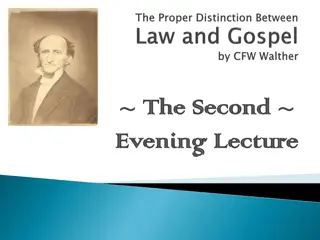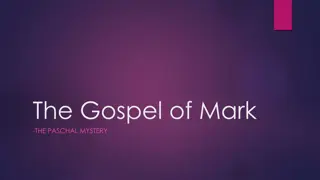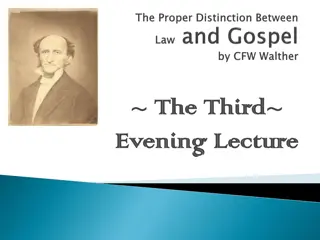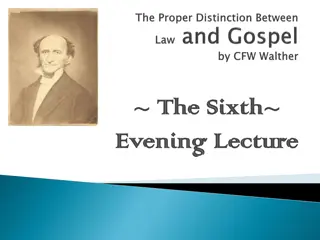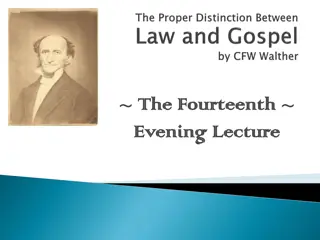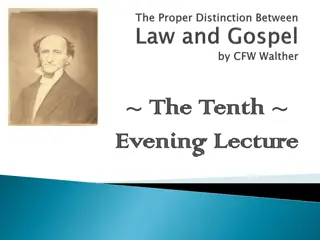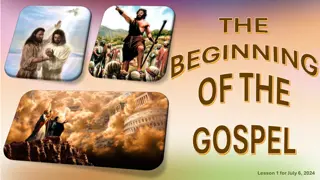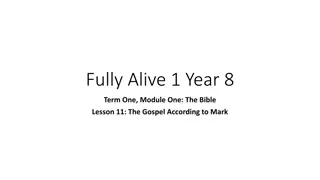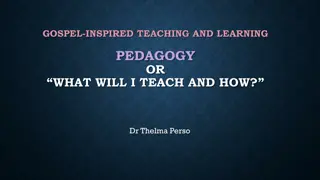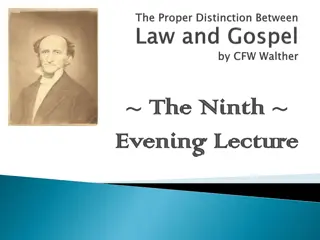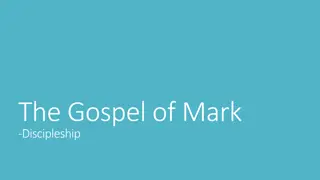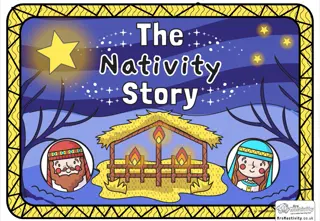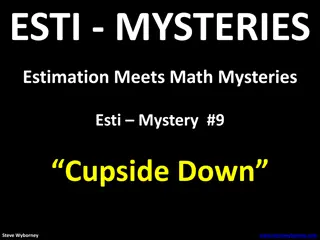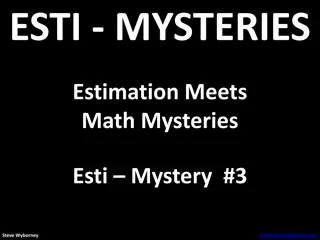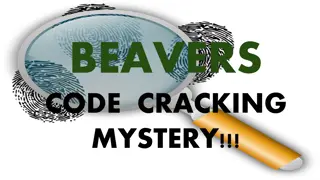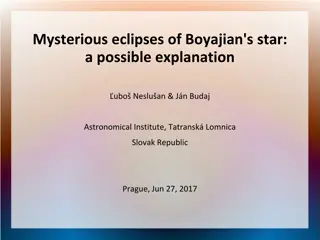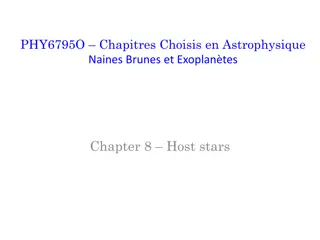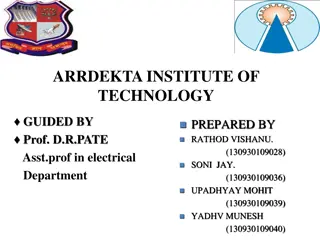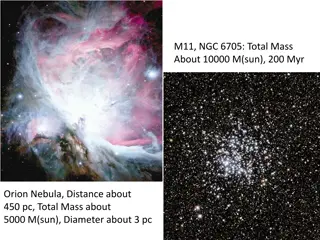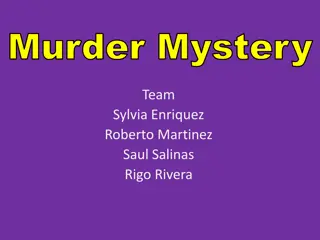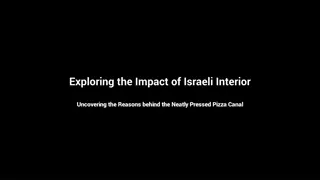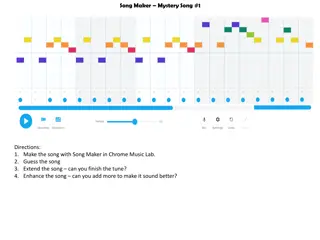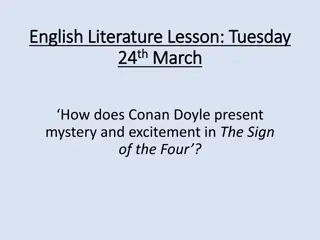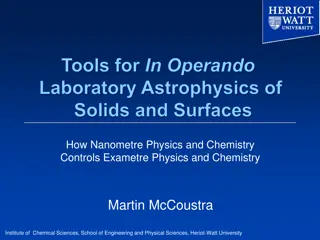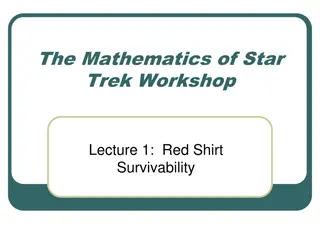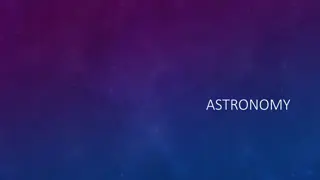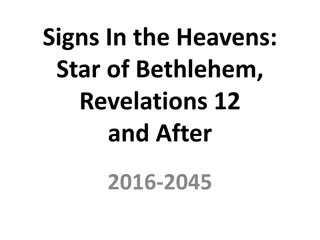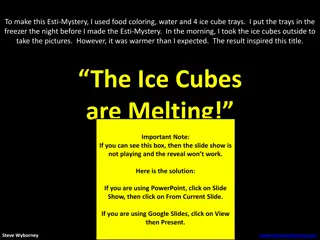The Star of Bethlehem: An Intriguing Mystery in St. Matthew's Gospel
The Star of Bethlehem, as described in St. Matthew's Gospel, has puzzled people for centuries. The account involves the Magi from the East, a mysterious star, and King Herod's disturbing response. Various theories and problems with the descriptions in the Gospel are explored, including the unique journey of the Magi and the enigmatic nature of the star. Michael Molnar's conclusion sheds light on what the Magi might have experienced, addressing the complexities within Matthew's narrative.
Download Presentation

Please find below an Image/Link to download the presentation.
The content on the website is provided AS IS for your information and personal use only. It may not be sold, licensed, or shared on other websites without obtaining consent from the author. Download presentation by click this link. If you encounter any issues during the download, it is possible that the publisher has removed the file from their server.
E N D
Presentation Transcript
The Star of Bethlehem What was it? EGR491/591 Telescope Design Fall 2019
What is The Star of Bethlehem? St. Matthew s Gospel account regarding birth of Jesus discusses a star indicating Jesus birth Involves the Three Wise Men/Kings/Magi Astrology was forbidden to the Jews and Christians yet, the Magi s story is recorded in the gospel Has intrigued people for centuries as to what it was Two major problems : Only the Magi appear to notice it Matthew s account has confusing descriptions
Overview Discuss the problems with the descriptions in Matthew s gospel Look at some proposed ideas as to what the star was Who were the Magi? What is astrology what is important for astrology Michael Molnar s conclusion Explains what the Magi saw Addresses the problems with Matthew s gospel account
Matthew, 2:1-16 1After Jesus was born in Bethlehem in Judea, during the time of King Herod, Magi[a] from the east came to Jerusalem 2and asked, Where is the one who has been born king of the Jews? We saw his star when it rose and have come to worship him. 3When King Herod heard this he was disturbed, and all Jerusalem with him. 4When he had called together all the people s chief priests and teachers of the law, he asked them where the Messiah was to be born. 5 In Bethlehem in Judea, they replied, for this is what the prophet has written: 6 But you, Bethlehem, in the land of Judah, are by no means least among the rulers of Judah; for out of you will come a ruler who will shepherd my people Israel. [b] 7Then Herod called the Magi secretly and found out from them the exact time the star had appeared. 8He sent them to Bethlehem and said, Go and search carefully for the child. As soon as you find him, report to me, so that I too may go and worship him. 9After they had heard the king, they went on their way, and the star they had seen when it rose went ahead of them until it stopped over the place where the child was. 10When they saw the star, they were overjoyed. 11On coming to the house, they saw the child with his mother Mary, and they bowed down and worshiped him. Then they opened their treasures and presented him with gifts of gold, frankincense and myrrh.
Magi from the east We saw his star when it rose and have come to worship him. ...When King Herod heard this he was disturbed the star they had seen when it rose went ahead of them until it stopped over the place where the child was. Troubling highlights of Matthew, 2:1-16 King Herod s response indicates he clearly did not notice the star. If the Magi are traveling west, how is a star in the east ahead of them? How can a star stop or come to rest ?
When was Jesus born? The Gregorian calendar date is based on the birth of Jesus BC = Before Christ AD = anno domini, Latin for in the year of the Lord, 525 AD was when BC/AD was established based on an estimate as to when Christ was born. 1BC should be the year before Jesus was born Based on biblical details (such as the rule of King Herod), historians now believe Jesus was born sometime 6 BC to 4 BC (or a few years either side)
Theorized astronomical events Johannes Kepler (17th cent.) speculated about tight conjunctions of Jupiter and Saturn in 7 BC making nova-like brightness. Modern calculations show the conjunction to be 1 full degree not nova-like A comet or nova, was seen by Chinese and Korean stargazers in about 5 BC. Comets were generally viewed as bad omens, not signs of a king s birth A nova or comet was recorded in China in about 4 BC. But there is no indication this occurred at a special time or location in the sky to suggest the birth of a king to astrologers from the east. None of these explain why Herod did not notice it, nor fit the biblical descriptions. https://en.wikipedia.org/wiki/Star_of_Bethlehem
Two dominant perspectives To fit the data , two dominant perspectives: No star like object can fit the data: it is a mythological story only It was a suspension of laws of nature (a miracle) Michael Molnar offers a third option: a real astronomical event that was interpreted as important by only a few (the Magi)
The Star of Bethlehem: The Legacy of the Magi, by Michael Molnar Michael Molnar, theory originated when he purchased a Roman coin of Antioch. It revealed that Aries the Ram was the sign of the Jews and that special star appeared in that sign of the zodiac. https://www.michaelmolnar.com/
Were likely to have been respected wise men who practiced Greek astrology. Who were the Magi? They lived east of Judea There is no biblical account of there being three magi, but rather three gifts: gold, frankincense, myrrh
What to look for? The problem with super star theories (nova, comet, etc.) these would have been noticed by everyone, not just the Magi Magi were not interested in super stars they were reading the sky
Astrology Magi (root of the word magic ) were important individuals they were astrologers thought capable of identifying important events Birth of kings and rulers Death of kings and rulers Catastrophic events or great events (losing or winning battles) Not daily horiscopes Sun, Moon, Planets, Stars are stars Alignments of stars with each other and within zodiacal signs are very significant
Astrological/Astronomical events and terms Conjunctions: when two non-stellar objects appear close to each other. Occultation: an event when one object is hidden by another object that passes between it and the observer. Retrograde motion (outer planets appear to move backward with respect to background stars). Change direction = comes to rest (or stood over ) Comes to rest
Astrological importance Conjunctions between planets, the moon, the sun Occultations are very important especially with sun at its rising. Occultations amplify the effect of conjunctions. Helical rising: when a planet rises in the east just before the sun. When the planet and sun are in the same zodiac sign and there is a helical rising, this is a very potent astrological event! Trines: three zodiacal constellations separated by 120 degrees. Specific planets are rulers of specific trines.
The stars align in Trine I Trine I: Aries, Leo, Sagittarius The 3 rulers of Trine I: Sun, Jupiter, Saturn Indicating royal birth in Judea: all 3 rulers in Aries But this alone is not sufficient to indicate a great king is to be born
6 BC April: The Rulers of Trine I (Sun, Jupiter and Saturn) are in Aries Indicating the birth of a king in Judea April 17: a new moon (adds importance to astrological events) April 17: Jupiter has a helical rising April 17: just before sunrise, the Moon Occults Jupiter in the east August of that year, Jupiter became stationary and then "went before" through Aries where it became stationary again on December 19, 6 BC.
Recap of problems in Matthews gospel account: King Herod s response indicates he clearly did not notice the star. If the Magi are traveling west, how is a star in the east ahead of them? How can a star stop or come to rest ?
Magi were astrologers. Magi from the east We saw his star when it rose and have come to worship him. Jupiter rising in the east, April 17, 6BC ...When King Herod heard this he was disturbed The Magi noticed something that Herod had not the star they had seen when it rose went ahead of them until it stopped over the place where the child was. The Magi would have been traveling by daylight, and would not be able to see star while they traveled. Ahead or follow implies being directed by something, not literally in front of. Stopped or stood still refers to retrograde motion (planet stops to change direction)
Conclusion Michael Molnar offers interesting insight to first century Greek astrology. His theory suggests: The Star of Bethlehem was a real event not a single star , not a myth, not a supernatural star The Star of Bethlehem that the Magi followed was an event : The Three Rulers of Trine I were in Aries (the sign of Judea) Jupiter helical rising was occulted by the Moon at Sunrise on April 17, 6 BC indicating the birth of a king in Judea (frightening King Herod) Jupiter came to rest (retrograde motion) in August, 6 BC signifying to the Magi they had arrived at the birth site of the King.




